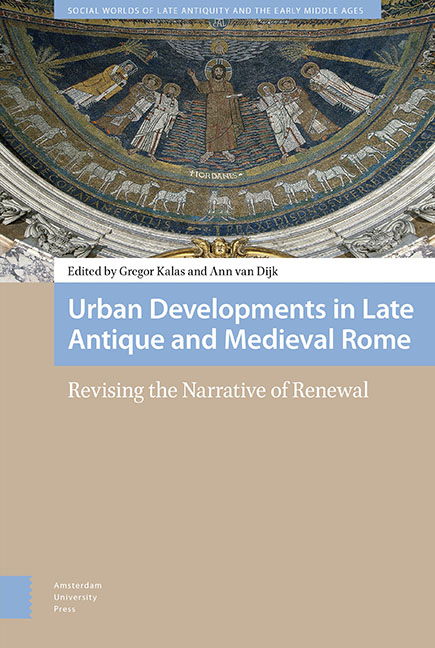Book contents
- Frontmatter
- Contents
- Preface and Acknowledgments
- List of Abbreviations
- 1 Introduction: Revising the Narrative of Renewal for Late Antique and Medieval Rome
- 2 Rome at War: The Effects of Crisis on Church and Community in Late Antiquity
- 3 Portraits of Poets and the Lecture Halls in the Forum of Trajan : Masking Cultural Tensions in Late Antique Rome
- 4 Rolling Out the Red Carpet, Roman-Style : The Arrival at Rome From Constantine to Charlemagne
- 5 (Re-)Founding Christian Rome: The Honorian Project of the Early Seventh Century
- 6 After Antiquity: Renewing the Past or Celebrating the Present? Early Medieval Apse Mosaics in Rome
- 7 The Re-Invention of Rome in the Early Middle Ages
- 8 Rewriting the Renouveau
- 9 Renewal, Heritage, and Exchange in Eleventh-Century Roman Chant Traditions
- 10 Reforming Readers, Reforming Texts: The Making of Discursive Community in Gregorian Rome
- Manuscripts Cited
- Index
9 - Renewal, Heritage, and Exchange in Eleventh-Century Roman Chant Traditions
Published online by Cambridge University Press: 18 June 2021
- Frontmatter
- Contents
- Preface and Acknowledgments
- List of Abbreviations
- 1 Introduction: Revising the Narrative of Renewal for Late Antique and Medieval Rome
- 2 Rome at War: The Effects of Crisis on Church and Community in Late Antiquity
- 3 Portraits of Poets and the Lecture Halls in the Forum of Trajan : Masking Cultural Tensions in Late Antique Rome
- 4 Rolling Out the Red Carpet, Roman-Style : The Arrival at Rome From Constantine to Charlemagne
- 5 (Re-)Founding Christian Rome: The Honorian Project of the Early Seventh Century
- 6 After Antiquity: Renewing the Past or Celebrating the Present? Early Medieval Apse Mosaics in Rome
- 7 The Re-Invention of Rome in the Early Middle Ages
- 8 Rewriting the Renouveau
- 9 Renewal, Heritage, and Exchange in Eleventh-Century Roman Chant Traditions
- 10 Reforming Readers, Reforming Texts: The Making of Discursive Community in Gregorian Rome
- Manuscripts Cited
- Index
Summary
Abstract
The creative outburst of the Roman schola cantorum – which ultimately led to the formation of the so-called Gregorian chant – was probably completed before the turn of the seventh century. The copying of the first notated manuscripts in Rome, however, dates to the mid-eleventh century at the earliest. Scholars have generally discussed Roman manuscripts either to speculate about the earlier, more pristine, status of the melodies, or for comparison with their Gregorian counterparts. This essay considers Roman chant manuscripts as documents of their own times. Through textual and melodic analysis as well as through examination of the manuscript tradition of selected pieces, it also redefines Roman influence upon other European centers in the later centuries of the Middle Ages.
Keywords: Gregorian chant, Roman chant, neo-Gregorian chant, tropes, Benevento, Montecassino
The provision of texts and melodies for the church rituals of medieval Rome must have been completed, at the latest, before the eighth century, when the considerable repertory that is generally called Roman chant was transmitted to Francia and eventually influenced the formation of Gregorian chant. It was about four centuries later, however, that the first large manuscript with musical notation, the gradual Cologny-Geneva, Bibliotheca Bodmeriana, 74 (henceforth Bod74) was copied in 1071 by the hand of Johannes Presbyter.
Because of an emphasis on the quest for the origins of Western chant and a perceived stylistic superiority of Gregorian over Roman chant, scholars have tended to examine chant books copied in Rome between the eleventh and the thirteenth centuries, more with the aim of reconstructing the status of the melodies before the transmission to Francia than for their intrinsic value as documents of their own times. Consequently, late compositions or signs of musical exchanges with other regions have either been overlooked or considered less worthy of examination.
The emphasis on the pre-eleventh century history of Roman chant has parallels in architectural studies, in which, as Sible de Blaauw remarks, the attention devoted to the early Christian and Carolingian history of Rome’s five patriarchal basilicas (St Peter’s, S. Giovanni in Laterano, S. Paolo fuori le Mura, S. Lorenzo fuori le Mura, and S. Maria Maggiore), for example, overshadowed the status and renovations that occurred to the same churches between the mid-eleventh and the end of the thirteenth centuries.
- Type
- Chapter
- Information
- Urban Developments in Late Antique and Medieval RomeRevising the Narrative of Renewal, pp. 279 - 298Publisher: Amsterdam University PressPrint publication year: 2021

